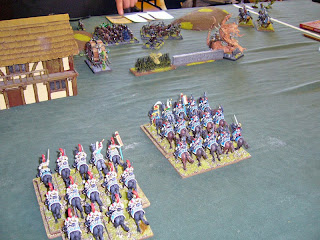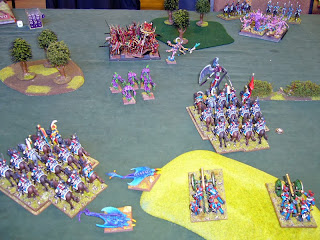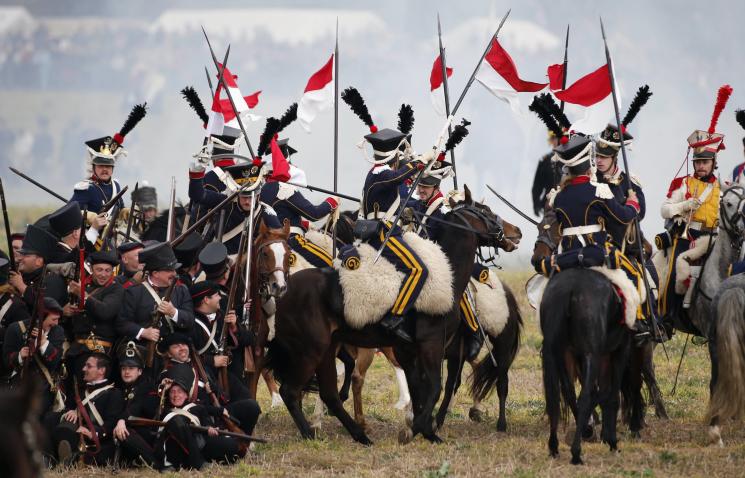As requested, below are set out the key rule interpretations and changes
to the
Black Powder rules (published by
Warlord Games), that our group used for
Project Leipzig 2013.
Woods (p.36, Black Powder)
We have adjusted the Black Powder rules around
woods to something that works:
- infantry halve their movement (i.e. 6”) in woods
and otherwise maintain a regular formation (i.e., do not go into skirmish
formation, but feel free to have your units look a little irregular);
- infantry with the skirmishing ability can chose to
deploy as skirmishers in woods and move normally i.e. 12”);
- shooting is restricted to 6” in woods and all enemy
count as not clear;
- infantry in woods do not get the +1 close range
or closing fire bonus for shooting.
- skirmishing infantry do count their normal
+1 bonus for being skirmishers;
- skirmishers in woods can fight in hand-to-hand and do
not suffer the -1 to hit as skirmishers;
- any unit that falls back as a result of a combat in
woods falls back the full distance (i.e., 12”).
Shooting (p.40 Black Powder)
We play that units which have moved three times with
a single order (or a follow me move) cannot shoot. They were far too busy moving.
Visibility (p.45 Black Powder)
We play that all units need a gap of at least 6” to
shoot through. Its just simpler that
way.
Disorder (p.48-49
Black Powder)
We play that disordered light cavalry (“Marauders”)
may rally back a full move to recover from disorder (instead of spending the
turn being unable to move). This move must take place within the rear quarter
of the cavalry.
Enfilading a Target (p.49
Black Powder)
We play that only fully formed troops can enfilade
a target – skirmishers cannot enfilade, nor can units in buildings or villages.
In addition, traversing fire cannot be enfilading fire.
Charges – interpenetration
(p.57 Black Powder)
We play that the final move of a charge cannot
involve interpenetration. Thus a charge made with an initiative move cannot
move through a friendly unit. However, a unit that would otherwise need to
interpenetrate a friend in a charge may move up to get into position to do a
final charge move (this should be specified in an order), and then charge home
– but this would require at least two moves.
Skirmishers do not create an impediment to charges
and can be interpenetrated in the final charge move.
Charges and the Follow Me order (p.59 Black Powder)
Black Powder is clear that charging units,
including with a follow-me order, can only charge the flank or rear of an enemy
if they start their turn in the flank or rear.
Otherwise a unit gets into position to charge a flank or rear in a
subsequent turn and stops at a suitable distance.
Charges – How many units can contact an enemy?
(p.60
Black Powder, &
Albion Triumphant)
For
Project Leipzig we expect a variation in basing styles. This requires a sensible and gentlemanly
approach that assumes a charger typically only contacts one enemy unit, with a
maximum of one unit contacting each flank.
When minor overlaps take place, simply move the offending unit 1” away
from the combat to show it is not involved.
There
are three key exceptions to this practice:
(1) Two infantry attack columns charge an infantry
line
A reasonably
common occurrence is for two infantry columns to charge an infantry unit in
line. Albion Triumphant adds the following useful (and balancing) rule,
which we play:
Infantry battalions can bring into contact as many
units as the rules on page 60 of Black Powder allow against an enemy formation.
However, only one battalion per facing can fight, being the owning player’s
choice, the other battalions being eligible as supports.
The unit chosen to fight does so with the following
rules, to represent the column needing to make a quick breakthrough.
If the column defeats the enemy in the first round
of combat and they flee and retire, it can be interpreted that the enemy turned
just prior to contact or after a brief bayonet fight. If this happens, the
other battalions in contact with the enemy get all the post melee options that
the victorious battalion gets.
If nobody breaks or retires then in the second and
subsequent rounds of combat, normal combat modifiers apply; but the attack
column does not get its +1 morale save for the column formation as its morale is
waning. This represents the column running out of steam and the enthusiasm of
the troops rapidly evaporating, whilst the battalion commanders are urging a
formation change to line.
Note –
we also play that attack columns lose their +1 morale save in the second or
subsequent round of any combat, such as if in hand to hand with another column
or artillery (god forbid such a combat goes longer than a turn!).
(2) Charging unit contacts two or more enemy in
the flank
Black
Powder allows a charging unit to contact more than one enemy unit in certain
circumstances. They key rule is that
half or more of the second unit’s frontage must be contacted by the charger. This will not happen very often in Project
Leipzig because there are no small or large units. But it is nevertheless possible for a unit to
charge the narrow flank of up to three enemy units (see third diagram on p.60,
or p.64).
(3) Charging
artillery batteries
Because
we model artillery batteries with 2 or 3 guns (rather than the 1 gun suggested
in Black Powder), it is almost impossible to produce the situation described at
p.60, where a charged battery draws an immediately adjacent unit into the
combat. This places artillery at a minor
disadvantage and does not allow the common practice of deploying an infantry of
cavalry unit on the flank of a battery to protect it.
We
therefore imagine that the contacted battery is 1 gun wide (about 2”), and wisely
assess the situation of adjacent units.
If there would have been a substantive overlap (i.e., half or more of
the neighbouring unit), then one
adjacent unit to the battery should be drawn into the combat (at the charger’s
choice). This additional unit will then get
normal charge responses allowed (i.e., counter-charging if Cavalry, firing
closing fire if infantry or artillery, evading if cavalry or horse artillery,
etc.).
This
generally means that a charging cavalry unit will overlap with all adjacent units,
including infantry in column or in line, another battery, or an adjacent
cavalry unit. However, a charging
infantry unit in attack column will not create a sufficient overlap if the
adjacent unit is cavalry or an infantry unit in line; but it will overlap with an adjacent battery or
an adjacent infantry column. Remember too
that closing fire from two units at a single charging unit is as not clear.
Even
then, one situation arises that is not clearly catered for in Black Powder, and
for which we play a specific rules modification: in the event a battery with an
adjacent infantry unit is charged by cavalry, the defending player declares
whether he wishes the artillery crew to i) stand by their guns or ii) run away! This is done at the same time as closing fire
– that is, immediately after the charge is declared, and before the enemy moves
any other units.
-
Stand
by your guns! If the
artillery chooses to remain in place by their guns, the defending player rolls for
the adjacent infantry to turn into square as normal. If successful (or if the infantry is already
in square) the cavalry charges home on the guns while the square is moved back
1” from the combat to make it obvious it is not involved. The battery fires closing fire and fights the
cavalry as normal.
If the square is not successfully formed or is
disordered (or shaken), the charging cavalry contacts and fights both the
square and the battery (taking closing fire from the battery as if a not
clear target).
- Run
away! If the artillery crew chose to
evade, the defending player rolls to form a square as normal. If a square is successfully formed (or if the
infantry was already in a square) the defending player then rolls a single dice
for the battery. On a 3+ the crew have
successfully escaped by running into the protection of the square (or a 4+ if
the cavalry charged with an initiative move).
The battery stays where it is (we only imagine the crew abandoning their
guns) and the cavalry halts 3” away from the square and the battery. The cavalry
player then, as normal, uses “whatever move remains to ride his cavalry back,
or around the side of the enemy, as he wishes” (p.75). The battery counts as disordered.
If the artillery does not succeed in running away, it fights the cavalry as normal without
the battery firing defensive fire. If
the cavalry wins and is not disordered or shaken, it may make a sweeping
advance.
Horse
artillery can of course evade as normal.
And note that a disordered or shaken battery may only stand by their
guns. Thus a battery that successfully
runs away from a charge (and returns to their guns disordered) can be charged
again in the same turn by another enemy unit if there is room.
Infantry Skirmishers Evading Cavalry (p.63 Black Powder)
We play that infantry skirmishers charged by cavalry
can evade a full move (12”) if the move takes them into terrain cavalry cannot
enter (i.e., a wood, an unoccupied village) or safely behind friendly troops. Remember
skirmishers may not fire closing fire (p.51).
Thus léger or jager battalions in skirmish order who stray too far from
“safe” terrain or friends are at risk of being ridden down by enemy cavalry (and
remember too, skirmishers fight at -1 to hit).
After evading the cavalry, infantry skirmishers are
disordered. This is an exception as evades
do not normally disorder the evader, unless they also needed to change
formation such as when cavalry in march column forms into skirmish order to
evade.
If infantry skirmishers successfully evade enemy
cavalry, we allow the cavalry to complete its final charge move into a new
enemy unit, if it has sufficient charge range and had received an appropriate
order. A typical order may be: “Charge into
contact with the nearest enemy. The
newly charged unit is allowed all normal responses – this is not a sweeping
advance.
If the charging cavalry had an order that specified
it would only charge the skirmishers,
it stops where it first contacted the enemy unit whether the unit evaded or not.
Break Tests for Closing
Fire (p.70 Black Powder)
Contrary to the Quick Reference Sheet (p.184), a charging
unit does not require a Break Test if they suffer a single hit from
artillery closing fire. A test is only required
if the charging unit is shaken by closing fire.
However, we play that a break test is required by “Stamina 4” units (i.e.
Guards or Grenadiers) if the unit takes 3 casualties while charging a battery.
Supporting Units See Friends Break from Hand-to-Hand (p.71 Black Powder)
The existing break test for seeing friends break is
too random and harsh (especially for artillery).
We play that supporting units who see friends break
read the result from the Shooting Break Test line (rather than
Hand-to-Hand results).
We also modify this test by +1 to
the dice for each point of Stamina the testing unit has (i.e., a fresh Stamina
3 unit will test at +3 if a friend it is supporting breaks).
Moving squares (p.74
Black Powder)
We play that a square cannot move or change
formation if an enemy cavalry unit is within 12” and is able to charge the
square. We found pinning squares by
cavalry too prohibitive and decided to exclude cavalry that is unable to
contact the square because of intervening friendly (or enemy) troops, not
having room to charge home, or because they would start a charge facing the
wrong direction and thus be unable to charge home – cavalry commanders thus
need to be more proactive in their deployment to pin enemy squares!
Cavalry riding past squares (p.74 Black Powder)
The Black Powder rules are not clear when allowing a
charging cavalry unit that has halted 3” from a newly formed square to use “whatever
move remains to ride his cavalry back, or around the side of the enemy, as he
wishes”. We play that the cavalry can
use both the balance of its final charge move and any additional movement
it may have from a successful 2 or 3-move order. However, the cavalry may not charge another
enemy formation as its “final charge move” is considered to have been
completed.
While cavalry can pass through any gap on the side
of a square (we do not allow players to form a “wall” of squares impassable to
cavalry), it must have sufficient space to deploy on the other side (or beside)
the square outside the required 3” gap. The
cavalry must also have sufficient space to move as a completed unit for the
balance of its move, if any (i.e., no more clever “flowing past” enemy units!).
Infantry of 1813 – forming square and mixed formation (pp.74, 78)
Reflecting the poor quality of most infantry in
1813, any infantry unit in line or march column that is charged by cavalry that
began its move within 12”, may not form square and is automatically disordered
when the cavalry contacts. This rule
does not apply to Grenadier or Guard infantry units, except the French Young
Guard who had plenty of élan but not so much drill.
French Provisional infantry and Prussian Landwehr
in line or march column may not form into square at any time if charged
by cavalry.
French Provisional infantry and Prussian Landwehr
may not use mixed formation (p.78).
Villages (in addition to buildings, p.77, Black Powder)
The
battle of Leipzig saw bloody street fighting for control of villages. A problem
in Black Powder is that fighting for
buildings is usually indecisive and results in few casualties. These village
rules overrule the section on ‘Fighting for Buildings’, except for specific
buildings (and defensive works) on the Leipzig board that will be identified to
players before the game:
- A village comprises a base area of around 8” x 8” or so, modelled with houses, hedges, walls, streets, etc., but with ability to re-arrange buildings as required to fit troops. Larger villages can be made up of two or more “bases”, so it is possible for the French to occupy one part of a village while the Allies hold out in another.
- Only one infantry unit can occupy a village “base”. Limbered artillery and other troops in March Column can pass through a village but may not end their move there.
- Villages are hard cover (+2 morale save) against shooting. A unit occupying a village may shoot 2 dice from each face of the village, up to their shooting value (they may not shoot enfilading fire however).
- Units attacking a village (only one unit per face) do not receive the normal +1 charge bonus, and do not get +1 to morale saves for being in attack column (the village breaks up formations and impetus).
- Defending units fight with all their combat dice and get +1 to morale saves against hits in hand to hand.
- Defenders in a village can both offer and receive support for combat results, as can attackers receive support.
- Defenders who roll a break test use the normal results (i.e. can retire).
- Fire! At Leipzig, parts of the villages caught fire. At the end of a hand-to-hand combat the defeated side rolls a dice – on a 6, the village has caught fire. At the start of every turn, a unit in a burning village must take a break test (using the shooting results table and adding +1 for every point of stamina a unit has). If they pass the break test and remain in the village, roll a second dice – on a 4+ the fire has been extinguished or has burnt itself out.
Brigade
Morale (p.97
Black Powder)
A brigade will break (and is removed from the
table) when more than half of its
non-Shaken combat units are destroyed. Small units and artillery are ignored
for this purpose. To make this calculation players add up the number of non-Shaken
units in a brigade to determine the brigade’s strength, and compare this to the
number of destroyed units.
Death of Commanders (p.86
Black Powder)
A commander that is killed in combat is replaced by
a commander with a Command rating of “7”.
Lastly
For further consideration the Blenheim to Berlin blog also has some Black Powder house rules posted, and I may add links to further lists of house rules for Black Powder as I come across them.






















































